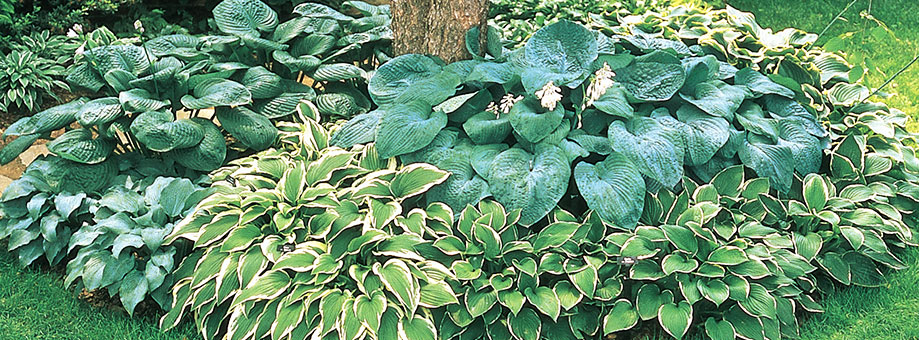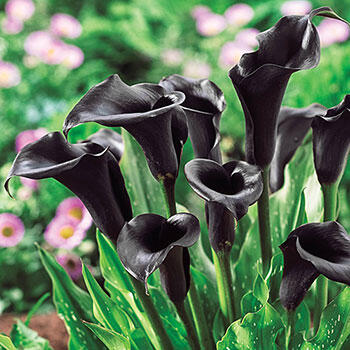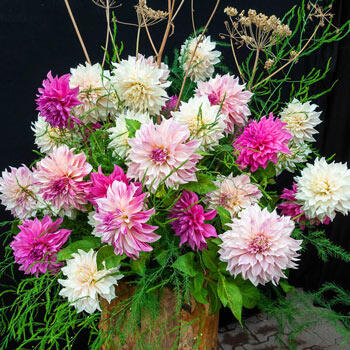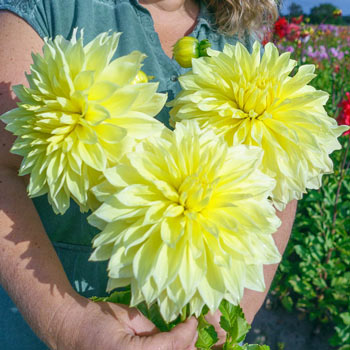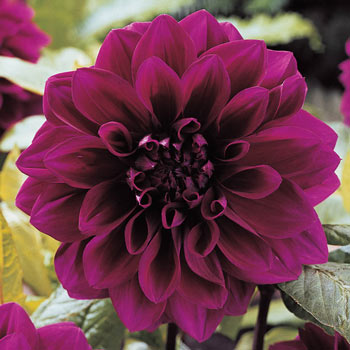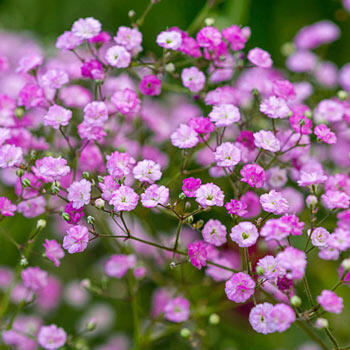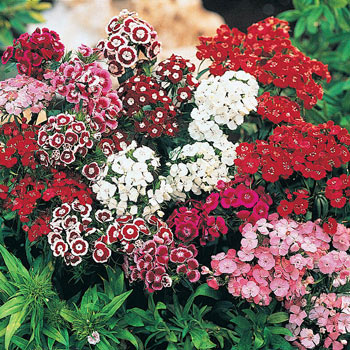- About Bulbs
- Landscaping Tips
- Planting & Care of Bulbs
- Tips for buying Bulbs & Perennials
- Planting &
Growing Instructions
- Allium Planting and Growing Tips
- Begonias Planting and Growing Tips
- Calla Lily Planting and Growing Tips
- Crocus Planting and Growing Tips
- Daffodil Planting and Growing Tips
- Dahlia Planting and Growing Tips
- Daylily Planting and Growing Tips
- Gladiolus Planting and Growing Tips
- Hosta Planting and Growing Tips
- Hyacinth Planting and Growing Tips
- Iris Planting and Growing Tips
- Lily Planting and Growing Tips
- Peony Planting and Growing Tips
- Rose Planting and Growing Tips
- Tulip Planting and Growing Tips
For many gardeners, any thoughts of hardy, unfinicky plants turn to hostas. Not sure what can survive in a dark corner of your yard? Hosta. Want to soften the edges of a driveway or walk? Hosta! Tired of using creeping plants as ground cover and want to go for something leafier? One word: Hosta. Continue reading on to learn more about planting hosta bulbs, growing hostas, and tips and tricks to help you care for your beautiful hosta plants!
Hostas can grow in shadier locations, and they lend a beautiful, tropical air to any garden. Hostas come in all varieties of shapes, textures, and colors - and that's just the leaves. Different types of Hostas also produce lily-shaped flowers in the summer, blooming on tall, elegant stalks. Those flowers add lovely dots of purple, lavender, or white to these green and glossy plants.
Some popular types of Hostas include
Siberian Tiger Hostas
Colored Hulk Hostas
White Feather Hostas
Fire and Ice Hostas
Kingsize Hostas
Lipstick Blonde Hostas
Glad Tidings Hostas
Magic Island Hostas
Paul's Glory Hostas
Bobcat Hostas
Snake Eyes Hostas
Praying Hands Hostas
Fried Bananas Hostas
Hostas can also be started in containers before being transported outside: you may find this tactic useful if you're in a cold climate and want to get your hosta started before the ground warms. Just pop the hosta into your container with loose, nutrient-rich soil and place them in indirect sun for about six weeks before you hope to transplant them outdoors!
Hostas can also serve as the centerpiece of a shade garden all on their own! Mix hostas of different sizes, shapes, and colors, or choose variegated or marbled hostas to add interest to your garden.
Miniature hostas can be used to decorate fence rows and line walks, or you can plant short hostas like Minnie Mouse varieties amongst other perennials in flower beds. Hostas benefit from extra moisture and humidity, so they're great for lining ponds and planting near fountains.
Your indoor hosta will need a period of dormancy in order to grow -- that's a departure from the other tropical houseplants you may keep. In the winter, move your potted houseplant to a garage or shed where it can rest in cool, dark conditions. Water it every month during the winter. Then, begin watering and fertilizing the plant when you bring it indoors.
To treat hostas for slugs and snails, sprinkle diatomaceous earth on and around your plants: the soft bodies of slugs and snails can't cross the rough material, and D.E. contains no harsh chemicals. Slug and snail bait is also available at your local hardware store. Some gardeners have luck setting beer traps. In order to set a beer trap for slugs, dig a trench near your affected plants and fill it with, that's right, any garden-variety beer! The slugs are attracted to beer, but cannot escape the trench once inside.
Click here to Download or Print
PDFs
What Are Hostas?
Hostas are one of the easiest-to-grow plants in the US, and they're cold-hardy in USDA Zones 3 through 9. Hostas are shade-tolerant plants and require very little maintenance and care. In short, anyone can grow hosta - and these foliage-heavy plants will be quick to reward you with big, bold "plant-y" looks.Hostas can grow in shadier locations, and they lend a beautiful, tropical air to any garden. Hostas come in all varieties of shapes, textures, and colors - and that's just the leaves. Different types of Hostas also produce lily-shaped flowers in the summer, blooming on tall, elegant stalks. Those flowers add lovely dots of purple, lavender, or white to these green and glossy plants.
Some popular types of Hostas include
How to Grow Hostas
Hostas are relatively easy to care for. Once planted, they quickly become established pieces of your landscape, and they'll happily grow for years. These plants are relatively carefree in terms of soli and light requirements, too. They are regularly browsed by wildlife, and are susceptible to slugs, so you may need to institute a bit of pest control.When to Plant Hostas
Plant hostas in early to mid spring, so that they have time to settle in before the hot summer months. Hostas can be planted relatively early in the season. Hostas are typically shipped as bare root bulbs, and you should plant them as soon as you receive them -- bare root plants don't like to wait around. If you're not able to plant your hostas immediately, be sure to store them in a cool, dry space.Hostas can also be started in containers before being transported outside: you may find this tactic useful if you're in a cold climate and want to get your hosta started before the ground warms. Just pop the hosta into your container with loose, nutrient-rich soil and place them in indirect sun for about six weeks before you hope to transplant them outdoors!
Where to Plant Hostas
Hostas are hardy in Zones 3 through 9, making them a popular plant all across the country. While most varieties can handle some sun, hostas grow best in partially or fully shady locations, and particularly prefer afternoon shade. For that reason, try planting hostas in the shadows of fences, outbuildings, or other plants. The exception: variegated and gold-colored hostas can handle more sun. The lighter the foliage, the brighter that sun your plant needs!Soil for Hostas
Hostas are also happy to live near water, as they can handle relatively moist soil. However, they do require lots of drainage, so you'll want to mix in compost, bone meal, or peat moss into the soil if you are in a heavy-clay area. If you have alkaline soil, consider mixing in some acidifier or lime, as hostas prefer slightly acidic soil. You'll only need to add soil amendments one time: once hostas are established, they take off and can grow in almost any soil.Overwintering Hostas
Hostas do just fine overwintering outdoors in temperate climates. You can clip back the foliage of your hostas in the fall. Wait until after the first few frosts, to allow the plant to prepare itself for winter before cutting. And, many hosta varieties sport beautiful fall foliage, and you don't want to miss out on the show! If you live in a particularly cold area, mulch over your hosta, and don't clear snow off your hosta garden: it helps to insulate your plants.How to Use Hostas in Your Garden
Hostas aren't low-growing creepers, but they still make great ground cover by simply taking up a space -- especially space where other plants would fail to thrive. Try planting a big-leafed hosta, like a Kingsize variety, to cover a wide area. Or, choose a hosta with bold leaves, like Fire and Ice, to turn a drab spot in your garden into a statement.Hostas can also serve as the centerpiece of a shade garden all on their own! Mix hostas of different sizes, shapes, and colors, or choose variegated or marbled hostas to add interest to your garden.
Miniature hostas can be used to decorate fence rows and line walks, or you can plant short hostas like Minnie Mouse varieties amongst other perennials in flower beds. Hostas benefit from extra moisture and humidity, so they're great for lining ponds and planting near fountains.
How to Divide Hostas
Hostas have a clumping root system that grows out as the plant grows up. They don't need to be divided for the health of the plant, but you can definitely divide hostas to maintain a neater appearance. And, you may just find that you want offshoots of your favorite hostas in different locations around your garden -- or, you might need to share a few baby hostas with your jealous friends and neighbors.When to Divide Hostas
Start by dividing hostas in the spring, while there's plenty of moisture available and before their leaves grow out for the summer. Wait for the hostas to sprout, but divide them before they bloom or grow to their fullest height. Gently dig up the hosta, and cut the root clump using scissors of a clean knife. Then, replant the hostas and water them well!Growing Hostas in Containers
Hostas can be grown as houseplants, but they can be a bit difficult. Hostas need frequent watering, so water your plant whenever the top inch of soil feels slightly dry. Fertilize once per month through the growing season. Direct sunlight is too bright and warm for an indoor hosta, so place hostas in containers in indirect light.Your indoor hosta will need a period of dormancy in order to grow -- that's a departure from the other tropical houseplants you may keep. In the winter, move your potted houseplant to a garage or shed where it can rest in cool, dark conditions. Water it every month during the winter. Then, begin watering and fertilizing the plant when you bring it indoors.
Hosta Pests and Frequently Asked Questions
Are Hostas Edible?
Yes, Hostas are edible! In fact, Hostas belong to the Asparagaceae family and can be enjoyed during meals as a garnish, can be stir-fried, sautéed, or used as an ingredient in your favorite sandwich or wrap. Hosta flowers are also edible and make for a colorful and vibrant garnish.Are Hostas Poisonous to Dogs and Cats?
While Hostas are edible for humans, Hostas actually contain a toxin called glycoside saponins, which is extremely poisonous to dogs and cats. If you suspect that your pet has eaten Hostas, your pet should be seen by a veterinarian or professional as consuming Hostas may cause your pet to vomit, have diarrhea, abdominal pain, bloating, possible twisting of intestines, distress, and loss of appetite.Do Hostas Attract Snails?
The big leaves, soft bases, and moisture preferences of hostas do make them vulnerable to various forms of mollusca (snails and slugs), and their tenderness tends to attract deer and rabbits. With a little planning ahead, you can keep pests and wildlife out of your hosta garden.To treat hostas for slugs and snails, sprinkle diatomaceous earth on and around your plants: the soft bodies of slugs and snails can't cross the rough material, and D.E. contains no harsh chemicals. Slug and snail bait is also available at your local hardware store. Some gardeners have luck setting beer traps. In order to set a beer trap for slugs, dig a trench near your affected plants and fill it with, that's right, any garden-variety beer! The slugs are attracted to beer, but cannot escape the trench once inside.







